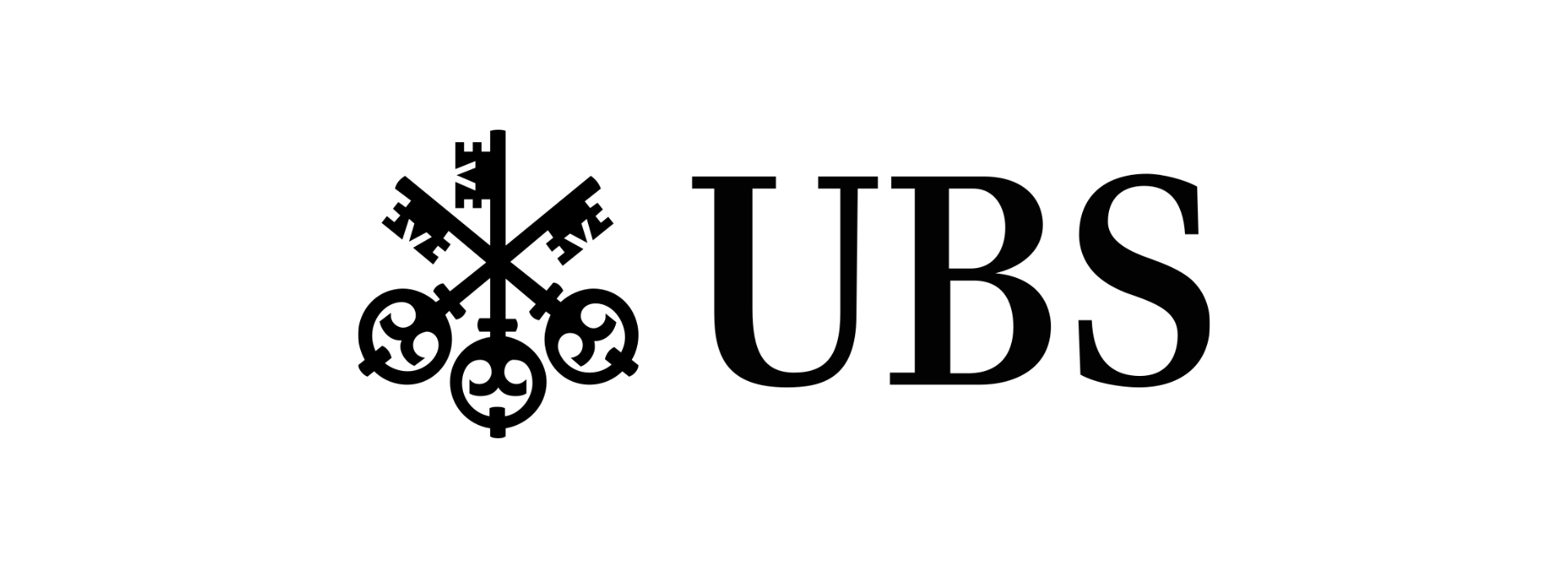Holbein and Dostojewski
The Dead Christ and its effect
The Dead Christ in the Tomb
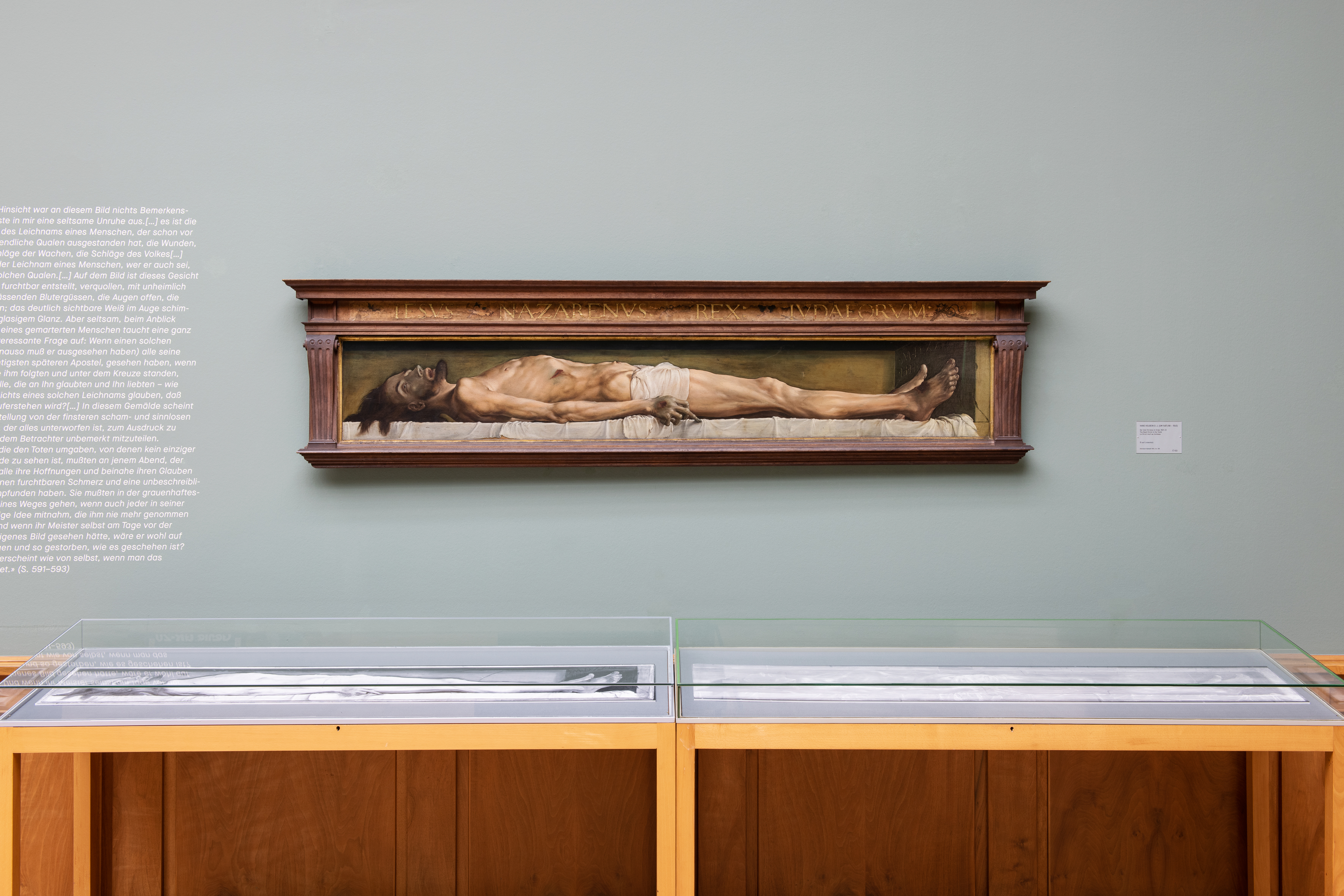
500 years ago, the Dead Christ in the Tomb was created by Hans Holbein the Younger, probably commissioned by Bonifacius Amerbach. How do we know this? From the painted inscription, a trompe l'oeil simulating stone carving on the side wall at the feet of the Saviour: "- M - D - XXI / - H - H -", i.e. 1521, followed by the master's initials.
But of all things, what seems to be set in stone presents a mystery: Infrared reflectography and X-rays of the painting show that the date in Roman numerals originally read 1522; Holbein painted over the last Roman numeral "I" with the same pigment he used for the surrounding surface, that is, while the work was still being completed. For some reason unknown to us, this backdating became necessary - presumably less a concern of the artist than of the patron. The project must therefore have begun in 1521 and been completed the following year.
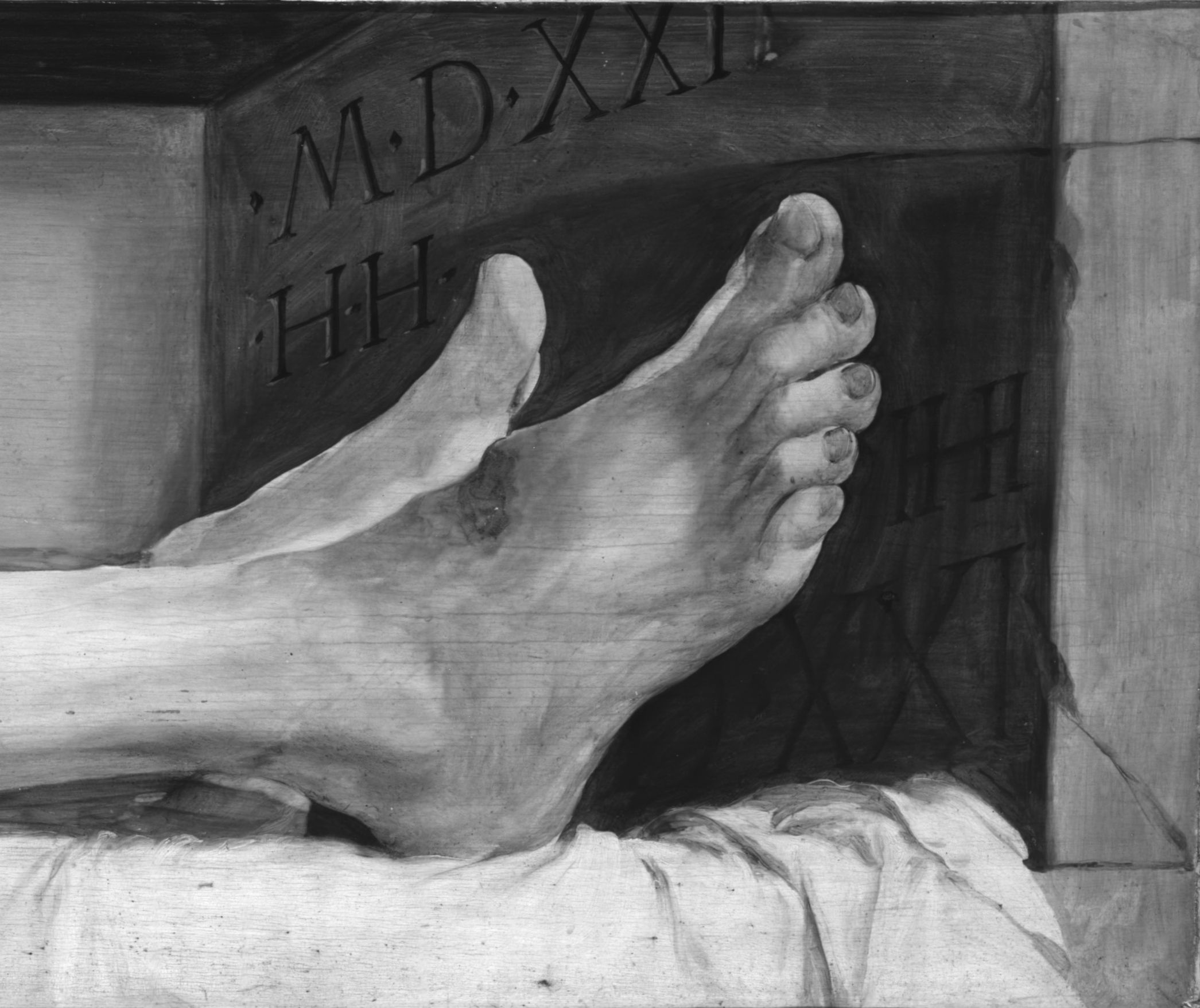
Infrared reflectography.

Radiography.
What is more, the backdating is apparently the last step in the course of a major reworking of the almost finished painting, which is also recognizable in the technical images: The tomb niche originally enclosed the corpse more scantily featuring a half-barrel vault that abutted the side wall with a quarter circle. In this first state Holbein had already dated the picture at the feet of the dead Christ: "D[half-visible] XXI". Only with the extension to a right-angled box-shaped niche the painter overpainted this first date and signature and placed another inscription at the top consisting of six or finally five digits for the year and a more elaborate form of his monogram.
This perhaps most unusual of all sacred Old Master paintings not only demands a lot from us; even contemporary viewers must have been confronted with features that were almost unique for them: the complete absence of living biblical personae, for instance (occurring also in a second version in private hands of Mantegna's Lamentation in the Brera in Milan) and the elongation of the corpse strictly parallel to the picture plane (comparable to Italian paintings with the Anointing of Christ on the stone). The depiction of Christ's tomb as a wall niche, however, is completely unique: it seems absent from both the occidental and the eastern church’s pictorial traditions until then.
In Holbein’s days, no artist could justify such a radical departure from tradition without the approval of his client: Amerbach and his friend Erasmus of Rotterdam are therefore most likely to have discussed the exact appearance of the Lord's tomb. There was every reason to do so; for contemporary pilgrims already doubted the authenticity of the so-called Aedicule of the Holy Sepulchre in the Jerusalem Church of the same name, and quite rightly so. Erasmus had been to Rome and Naples and could have seen ancient and early Christian catacombs with wall tombs there corresponding to the one in Holbein's painting. And there is evidence that the subject occupied Amerbach precisely at the turn of the year in question: on December 16, 1521, he borrowed the classic among the descriptions of the Holy Land and its monuments from the library of the Charterhouse in Basel, the "Peregrinatio in terram sanctam" by Bernhard von Breydenbach, published in 1486. The volume he held in his hands while the Dead Christ stood on Holbein's easel is now in the Basel University Library (cf. reproduction).
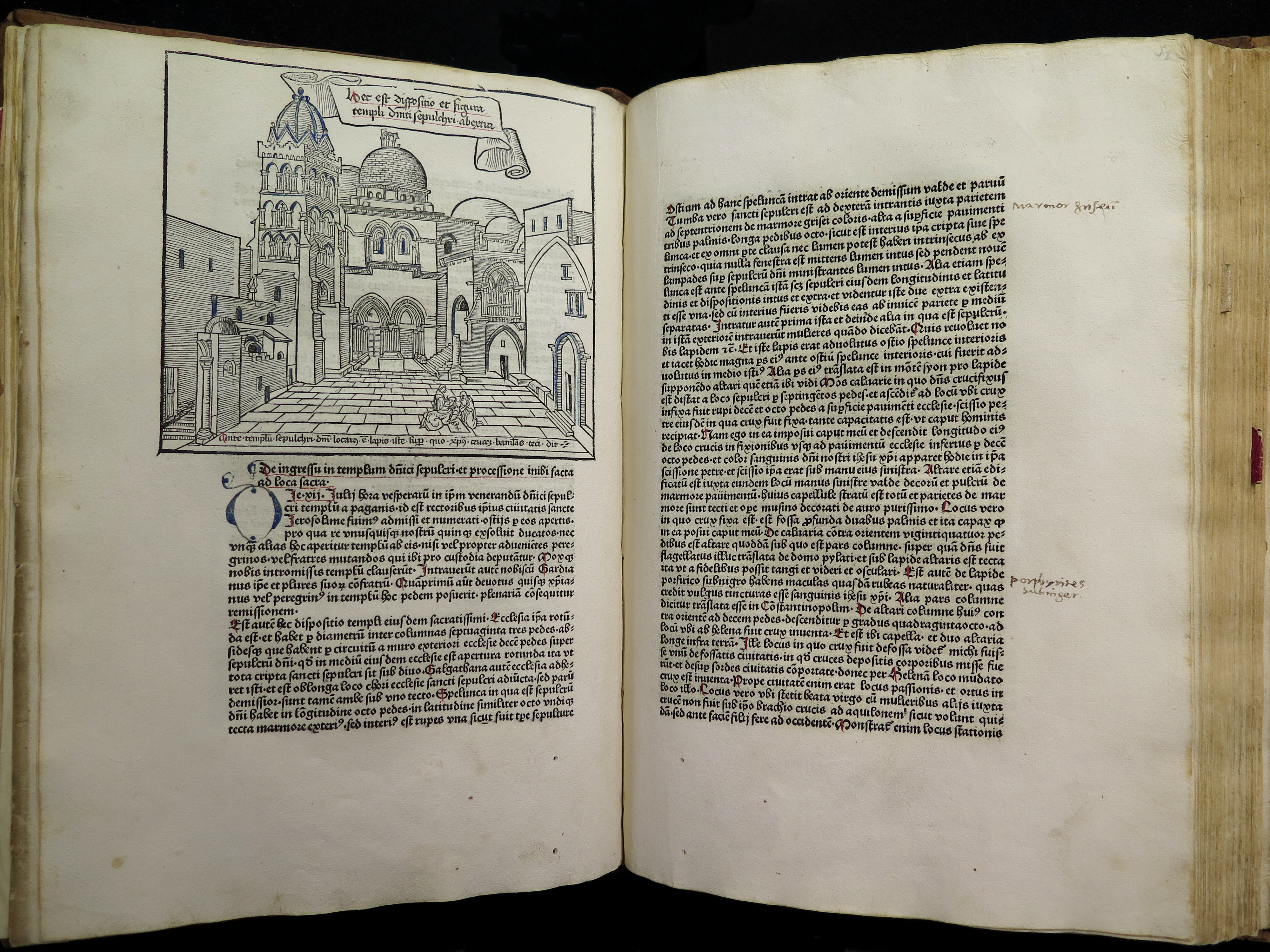
Bernhard von Breydenbach, Peregrinatio in terrram sanctam, Mainz 1486. © Universitätsbibliothek Basel
Most likely, the hitherto unique subject of the body of Christ placed strictly parallel to the picture plane in the wall niche of his Jerusalem burial cave thus goes back to instructions of Bonifacius Amerbach that the latter gave after consultation with Erasmus of Rotterdam. Whether the realistic depiction of the body of an executed man that went with it results from demands of the patron or from the ambition of the painter will probably never be determined with certainty. After all, according to what we know, the three people involved were friends who, to our dismay, did not have to put anything in writing in this case as they were able to speak to each other in person.
Fyodor Mikhailovich Dostoevsky
Fyodor Mikhailovich Dostoevsky (1821-1881) was born in Moscow 200 years ago, the same year as Gustave Flaubert and Charles Baudelaire. With the latter, he ranks among the most important writers of the 19th century.
A visit in 1867 connects him with the Kunstmuseum Basel and in particular with Holbein's Dead Christ in the Tomb. His second wife Anna Grigorievna Dostoevskaya reports in her memoirs:
“On our way to Geneva, we stopped for a day in Basel to see a painting in the museum there that my husband had heard about. This painting by Hans Holbein depicts Christ who has endured inhuman torment, already taken down from the cross and decaying. His bloated face is covered with bloody wounds and his appearance is terrible. The painting had a crushing impact on Fyodor Mikhailovich. He stood before it as if stunned. And I did not have the strength to look at it – it was too painful for me, particularly in my sickly [pregnant] condition – and I went into the other rooms. When I came back after fifteen or twenty minutes, I found him still riveted to the same spot in front of the painting. His agitated face had a kind of dread in it, something I had noticed more than once during the first moments of an epileptic seizure. Quietly I took my husband by the arm, led him into another room and sat him down on a bench, expecting the attack from one minute to the next. Luckily this did not happen. He calmed down little by little and left the museum, but insisted on returning once again to view this painting which had struck him so powerfully.”

Holbein Hall in the Augustinergasse Museum, condition before 1907. Did Dostoyevsky climb onto one of these chairs or one of the predecessors of this furniture? © Kunstmuseum Basel, Archive
Still under the impression of some bizarre details of the visit, she had noted in her diary on August 24 (12 according to the Julian calendar), 1867:
“The lady invited us to enter and showed us the paintings of Holbein the Younger. In the whole museum there are only two masterpieces, namely the Dead Saviour, a marvellous work, which almost terrified me and made such an impression on Fedya [short for Fyodor] that he declared Holbein to be an outstanding artist and poet. Usually Jesus Christ is depicted after his death with a distorted face full of suffering, while the body does not look in the least martyred and tortured; but this must have been actually the case. Here, however, the body is gaunt, the ribs and bones are visible, hands and feet are torn by wounds, swollen and blue, as in the case of a corpse that is already in the process of decomposition. The face is also terribly tormented, the eyes are half open, but without expression and already without sight. The nose, mouth and chin are blue; the whole is so eerily similar to a real corpse that I would not like to be alone in a room with this image. I admit that it is true to nature, but I cannot find it at all aesthetic, and in me it aroused only disgust and horror. Fedya, however, was enraptured by it and, wishing to see it more closely, he climbed on a chair, so that I was in great fear that he would have to pay a fine, because here one has to pay a fine all the time. The second painting worth seeing, which used to belong to a private gallery, is "Sea View" by Calame. It is a magnificent painting, the like of which I have never seen.”
At that time, Dostoevsky was preparing his third great novel The Idiot, which he subsequently wrote down in Geneva, Vevey, Milan and Florence (published as a feuilleton novel in 1868/69). Throughout the book, the Basel museum visit has left traces in five places, and three paintings of the Kunstmuseum are evoked: Hans Fries' Beheading of John the Baptist, the Dead Christ by Hans Holbein the Younger in three separate passages, and the Dresden Madonna, then still considered an autograph work by Holbein. The Dostoevskys had indeed studied the original of the latter in Dresden a few months earlier; but the copy by Julius Grüder, which had recently entered the Basel Museum at the time, may have brought this encounter back to their minds.
Dostoevsky's The Idiot
The Dead Christ by Hans Holbein the Younger is mentioned three times (cf. excerpts on the wall) in "The Idiot": First, the painting – or, to be more precise, a copy of it of identical size – is the subject of a short dialogue between Prince Myshkin and Rogozhin which the Prince reviews soon after on his way through St. Petersburg. The canvas hangs amid other paintings in Rogozhin's apartment. Many hundreds of pages later, the 18-year-old Ippolit Terentyev, terminally ill, dedicates a long paraphrase to Rogozhin’s copy in his "Necessary Declaration" (cf. the opened copy of the novel here), an intellectual legacy that he reads with the intention of committing suicide immediately afterwards.
When Dostoevsky mentions works of visual art here, he is concerned last of all with their correct description. Rather, he uses them to bring out the attitudes and points of view of his characters as they reflect on the subject and style. The first and last passages devoted to the Dead Christ are therefore very different: The first is succinctly formulated, the last exceedingly lengthy. In the first, the prince authenticates the painting at first glance as an excellent copy after Holbein; in the last, Ippolit just as quickly attests to the same work no artistic significance at all. In the first, the painting is once briefly and succinctly titled as a depiction of the Saviour taken down from the cross, in the last, it is repeatedly referred to as just the corpse of a human being.
The dualism between the sacrificial body of the Lord to be worshipped on the one hand and the realistically depicted corpse causing shudder and pity on the other leads to the atheistic core thesis, which the two protagonists in turn interpret quite differently. For the prince, the painting has the potential in the presence of the narrative to cause a believing viewer to apostatize; the spontaneously flashing thought deeply dismays him.
On the other hand, starting from the unconditional truth in the image, Ippolit extrapolates that the historical corpse of Christ must have looked exactly so terrible, and links this to the doubt whether the disciples and women at the tomb (who, as he correctly notes, are absent from the painting) could have believed in a resurrection of the Lord at all. The sight of the painting would have prevented even Christ himself from enduring his Passion – which, however, would ultimately have deprived the artwork of its subject and thus prevented its creation.
Like a concave mirror, Ippolit's personal reception of the painting brings into focus the radical and aporetic thinking of the nihilistic youth. Prince Myshkin's reaction to the same work of art, on the other hand, springs from the intuitive humanity with which Dostoevsky grounds his main character. And the terse reply of the self-tormenting Rogozhin foreshadows the latter's doomed fate as a murderer, whom the prince will nevertheless accompany with altruistic empathy to the bitter end.
Fjodor Dostojewskij: Der Idiot. Roman. Aus dem Russischen von Swetlana Geier, Zurich 1996
Quotes from “The Idiot”
Quotes from “The Idiot”:
“You too, Alexandra Ivanovna, have a very lovely face; but I think you may have some secret sorrow. Your heart is undoubtedly a kind, good one, but you are not merry. There is a certain suspicion of ‘shadow’ in your face, like in that of Holbein’s Madonna in Dresden.
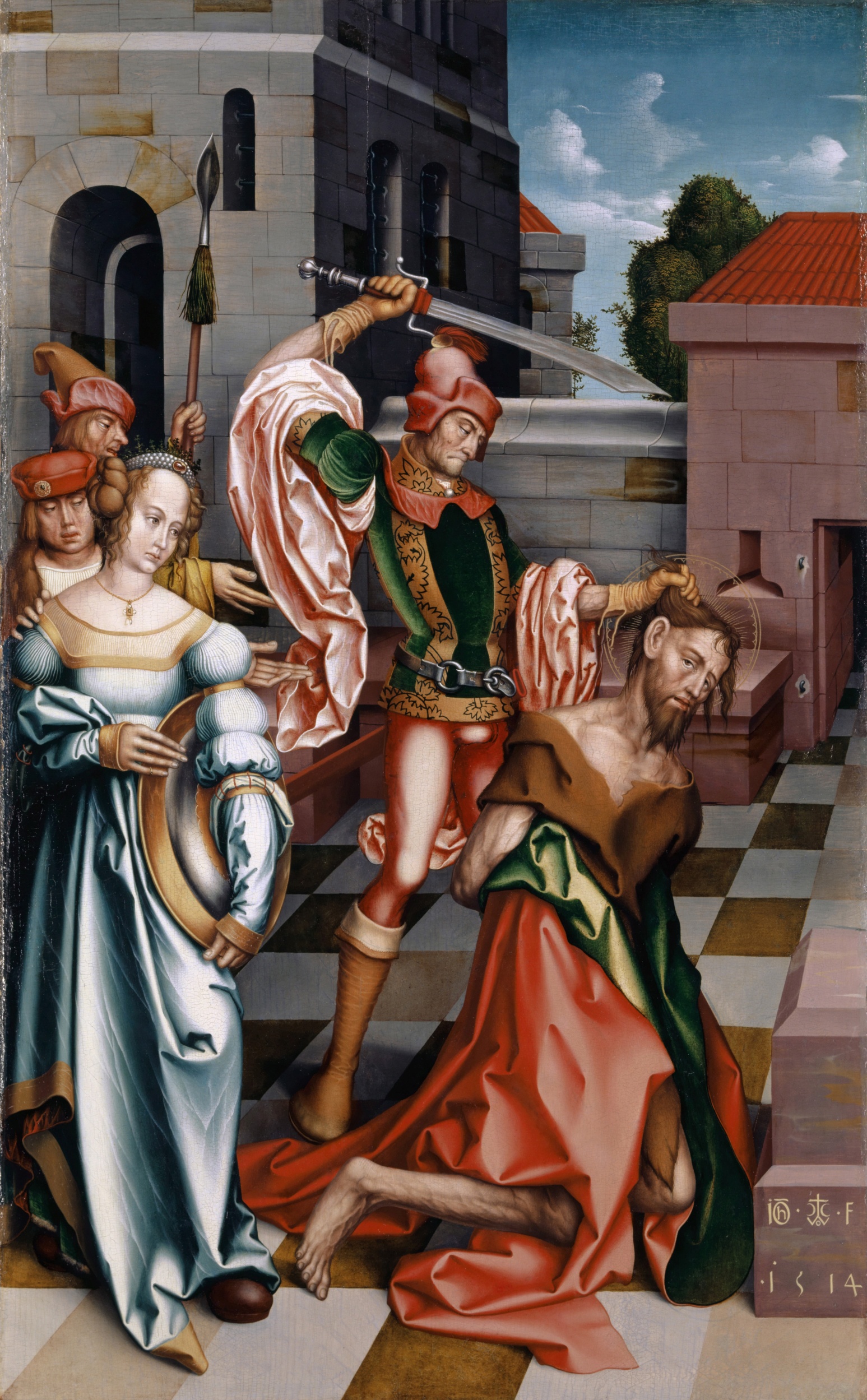
Hans Fries, Die Enthauptung Johannes des Täufers, 1514, Kunstmuseum Basel.
“Just now, I confess,” began the prince, […] “when you asked me for a subject for a picture, I confess I had serious thoughts of giving you one. I thought of asking you to draw the face of a criminal, one minute before the fall of the guillotine, while the wretched man is still standing on the scaffold, preparatory to placing his neck on the block.”
“What, his face? only his face?” asked Adelaida. “That would be a strange subject indeed. And what sort of a picture would that make?”
“Oh, why not?” the prince insisted, with some warmth. “When I was in Basle I saw a picture very much in that style—I should like to tell you about it; I will some time or other; it struck me very forcibly.”
[…]there were pictures on the walls, portraits and landscapes of little interest. Over the door, however, there was one of strange and rather striking shape; it was six or seven feet in length, and not more than a foot in height. It represented the Saviour just taken from the cross.[…]
“Yes—that’s a copy of a Holbein,” said the prince, looking at it again, “and a good copy, too, so far as I am able to judge. I saw the picture abroad, and could not forget it[…]”
“Lef Nicolaievitch,” said Rogojin, after a pause, during which the two walked along a little further, “[…]do you believe in God?”
“How strangely you speak, and how odd you look!” said the other, involuntarily.
“I like looking at that picture,” muttered Rogojin, not noticing, apparently, that the prince had not answered his question.
“That picture! That picture!” cried Muishkin, struck by a sudden idea. “Why, a man’s faith might be ruined by looking at that picture!”
“So it is!” said Rogojin, unexpectedly.
That gloomy Parfen [Rogojin] had implied that his faith was waning; he must suffer dreadfully. He said he liked to look at that picture; it was not that he liked it, but he felt the need of looking at it. […]He was fighting for the restoration of his dying faith. He must have something to hold on to and believe, and someone to believe in. What a strange picture that of Holbein’s is!
“There was nothing artistic about it, but the picture made me feel strangely uncomfortable.[…] This was the presentment of a poor mangled body which had evidently suffered unbearable anguish even before its crucifixion, full of wounds and bruises, marks of the violence of soldiers and people,[…]
“The face was depicted as though still suffering; as though the body, only just dead, was still almost quivering with agony. The picture was one of pure nature, for the face was not beautified by the artist, but was left as it would naturally be, whosoever the sufferer, after such anguish.
“It is strange to look on this dreadful picture of the mangled corpse of the Saviour, and to put this question to oneself: ‘Supposing that the disciples, the future apostles, the women who had followed Him and stood by the cross, all of whom believed in and worshipped Him—supposing that they saw this tortured body, this face so mangled and bleeding and bruised (and they must have so seen it)—how could they have gazed upon the dreadful sight and yet have believed that He would rise again?[…]
“This blind, dumb, implacable, eternal, unreasoning force is well shown in the picture, and the absolute subordination of all men and things to it is so well expressed that the idea unconsciously arises in the mind of anyone who looks at it. All those faithful people who were gazing at the cross and its mutilated occupant must have suffered agony of mind that evening; for they must have felt that all their hopes and almost all their faith had been shattered at a blow. They must have separated in terror and dread that night, though each perhaps carried away with him one great thought which was never eradicated from his mind for ever afterwards. If this great Teacher of theirs could have seen Himself after the Crucifixion, how could He have consented to mount the Cross and to die as He did? This thought also comes into the mind of the man who gazes at this picture.”
